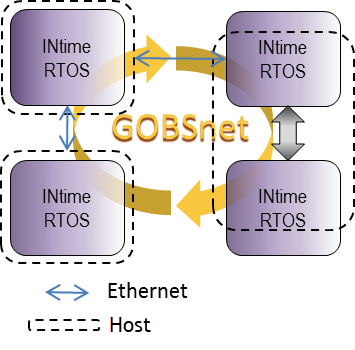

INtime RTOS is an object-based, real-time operating system that can be configured to run in several concurrent instances on a PC, with each RTOS capable of running high-speed process loops. There are two product configurations:
INtime for Windows allows Windows and INtime environments to run independently on the same platform, partitioning resources to avoid conflict and to ensure the integrity of each environment. In addition, INtime for Windows provides a managed communication environment for Windows and INtime applications to communicate at the process level, allowing the applications to interact.
The next figure shows how feature-rich and real-time components of a system application are typically partitioned on a platform running INtime for Windows. Components such as advanced user interfaces can leverage Windows strengths while time-critical components run on the INtime RTOS.

INtime for Windows runs with standard off-the-shelf Windows and can take advantage of multicore PC architectures to create multiple partitions for different system functions. This partitioned architecture is a key feature of the INtime family of products and allows multiple system functions to operate independently on the same PC. Multiple real-time partitions may be created on a multi-core platform. These partitions are known as “nodes” in the INtime environment.
INtime Distributed RTOS is a stand-alone implementation of the INtime kernel offering the same functionality as the INtime for Windows product, but without the requirement to co-locate with Windows. Platform partitioning is still an important component of this product, allowing multiple subsystems to be consolidated onto a single platform while maintaining their independence. One node provides basic services for the whole platform such as disk access and system network communications.
A second key feature of the INtime products is that applications running in different nodes are still able to communicate using the same IPC methods as between applications running on the same node. A software layer, called GOBSnet, extends access to remote objects by local processes and manages inter-node communications and monitoring. This service is also extended across a network connecting multiple INtime hosts.
The next figure shows multiple INtime nodes communicating via GOBSnet, with two of them implemented as a single dual-core processor platforms and the others as separate single core processor platforms. Individual applications can run independently on each core or a single application can be distributed across the multiple INtime nodes.

All development is performed with the INtime SDK running on a Windows PC and comes as a complete solution with tools and utilities to facilitate the development, deployment, and field maintenance of embedded real-time applications. Code development uses Microsoft Visual Studio on a standard Windows based PC platform, programming in C and C++.